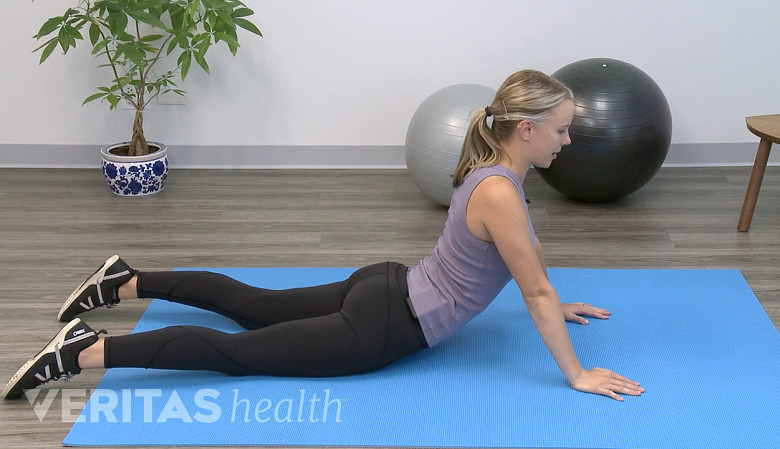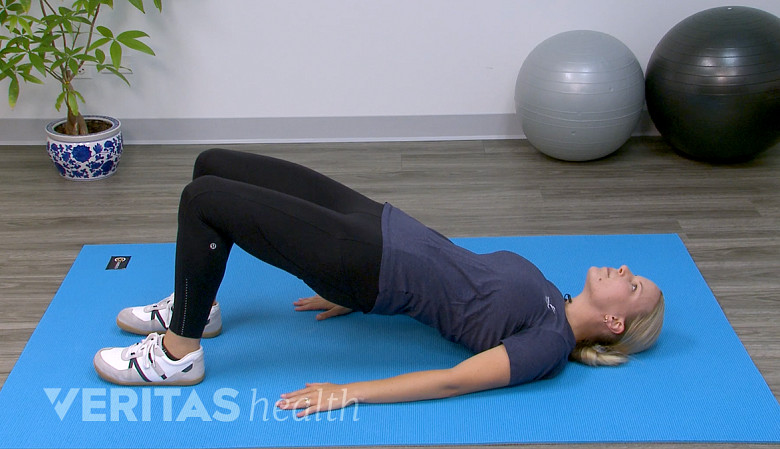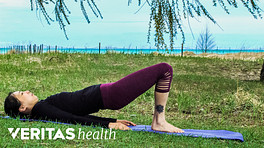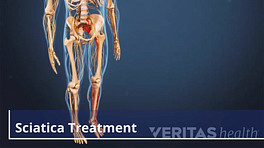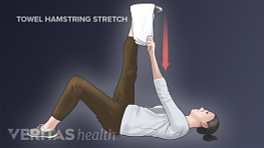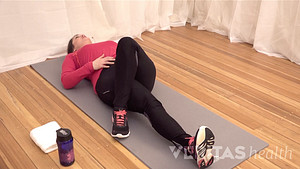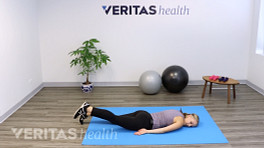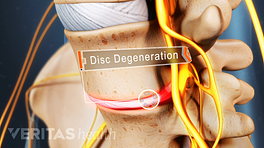Treatment for sciatica pain will almost always involve a controlled, progressive exercise program. The exercise treatment helps address, resolve, and prevent recurrences of the underlying cause of pain.
Targeted sciatica exercises serve the following main purposes:
- Reduce acute sciatic nerve pain
- Improve leg mobility and range of motion
- Promote soft tissue healing
- Improve sciatic nerve function
- Provide muscle and soft tissue conditioning
- Prevent, or at least minimize, recurrence of pain
To be effective, therapeutic exercises must be done regularly and as prescribed, using the specific form and program. Close attention to exercise posture and body mechanics is a challenge but is essential for the exercises to be effective.
In This Article:
Exercise Provides Sciatica Pain Relief
While it may seem counterintuitive, exercise is more effective in relieving sciatica pain than bed rest or staying active with daily physical activities. 1 Koes B. Moderate quality evidence that compared to advice to rest in bed, advice to remain active provides small improvements in pain and functional status in people with acute low back pain. Evidence-Based Medicine. 2010;15(6):171-172. doi:10.1136/ebm1132 , 2 Fernandez M, Hartvigsen J, Ferreira ML, et al. Advice to Stay Active or Structured Exercise in the Management of Sciatica. Spine. 2015;40(18):1457-1466. doi:10.1097/brs.0000000000001036 Prescribed exercise is different from physical activity because it is planned, structured, repetitive, and a progressive process validated in improving overall fitness. 3 Dasso NA. How is exercise different from physical activity? A concept analysis. Nurs Forum. 2019 Jan;54(1):45-52. Available at: https://pubmed.ncbi.nlm.nih.gov/30332516/
While a short period of rest and limited movement may be necessary when the sciatica pain flares up, long periods of inactivity usually make the pain worse. With prescribed exercise, sciatica pain is relieved due to the following tissue changes:
- Increased muscle strength. Exercise increases the activation (proper engagement of the muscle) and area of the deep muscle fibers, improving muscle strength. 4 Mu W, Shang Y, Mo Z, Tang S. Comparison of two types of exercises in the treatment of lumbar spinal stenosis. Pak J Med Sci. 2018;34(4):897–900. doi:10.12669/pjms.344.15296 , 5 Pourahmadi MR, Taghipour M, Ebrahimi Takamjani I, Sanjari MA, Mohseni-Bandpei MA, Keshtkar AA. Motor control exercise for symptomatic lumbar disc herniation: protocol for a systematic review and meta-analysis. BMJ Open. 2016;6(9):e012426. Published 2016 Sep 27. doi:10.1136/bmjopen-2016-012426 Strong muscles help support the spine, improving its stability. 6 National Guideline Centre (UK). Low Back Pain and Sciatica in Over 16s: Assessment and Management. London: National Institute for Health and Care Excellence (UK); 2016 Nov. (NICE Guideline, No. 59.) 9, Exercise therapies. Available from: https://www.ncbi.nlm.nih.gov/books/NBK410131/ , 7 Hagen KB, Dagfinrud H, Moe RH, et al. Exercise therapy for bone and muscle health: an overview of systematic reviews. BMC Med. 2012;10:167. Published 2012 Dec 19. doi:10.1186/1741-7015-10-167 , 8 Lee JS, Kang SJ. The effects of strength exercise and walking on lumbar function, pain level, and body composition in chronic back pain patients. J Exerc Rehabil. 2016;12(5):463–470. Published 2016 Oct 31. doi:10.12965/jer.1632650.325 Pain from muscle fatigue is also reduced.
- Improved bone health. Exercise increases bone density, resulting in stronger bones. The quality of bone in conditions such as osteoporosis and bone pain from arthritis and ankylosing spondylitis have shown to improve with exercise. 7 Hagen KB, Dagfinrud H, Moe RH, et al. Exercise therapy for bone and muscle health: an overview of systematic reviews. BMC Med. 2012;10:167. Published 2012 Dec 19. doi:10.1186/1741-7015-10-167 , 9 "Benefits of Exercise," MedlinePlus, 08-Feb-2019. [Online]. Available: https://medlineplus.gov/benefitsofexercise.html. [Accessed: 30-May-2019]
- Enhanced blood flow. Blood flow to the muscles, nerves, and other soft tissues in the spine is increased with exercise. This process results in a better supply of nutrients to these tissues, promoting healing and relieving stiffness. 8 Lee JS, Kang SJ. The effects of strength exercise and walking on lumbar function, pain level, and body composition in chronic back pain patients. J Exerc Rehabil. 2016;12(5):463–470. Published 2016 Oct 31. doi:10.12965/jer.1632650.325 , 10 Jeong UC, Kim CY, Park YH, Hwang-Bo G, Nam CW. The effects of self-mobilization techniques for the sciatic nerves on physical functions and health of low back pain patients with lower limb radiating pain. J Phys Ther Sci. 2016;28(1):46–50. doi:10.1589/jpts.28.46
- Nourished spinal discs. The spinal discs between the spinal vertebrae exchange fluids to receive nutrition and stay healthy. A healthy disc swells with nutrients and water and squeezes it out, similar to the action of a sponge. This action improves when forces are applied to the disc during exercise, distributing nutrients throughout the disc. 11 Belavý DL, Albracht K, Bruggemann G-P, Vergroesen P-PA, van Dieën JH. Can Exercise Positively Influence the Intervertebral Disc? Sports Medicine. 2015;46(4):473-485. doi:10.1007/s40279-015-0444-2
- Reduced stiffness of the sciatic nerve. Stiffness of the sciatic nerve can be improved through nerve glide (nerve stretching) or mobilization exercises. These exercises help maintain the flow of nutrients between the nerve and surrounding tissues, increasing its flexibility. This process also reduces nerve swelling and reverses negative immune system changes. 10 Jeong UC, Kim CY, Park YH, Hwang-Bo G, Nam CW. The effects of self-mobilization techniques for the sciatic nerves on physical functions and health of low back pain patients with lower limb radiating pain. J Phys Ther Sci. 2016;28(1):46–50. doi:10.1589/jpts.28.46 , 12 Andrade RJ, Freitas SR, Hug F, et al. The potential role of sciatic nerve stiffness in the limitation of maximal ankle range of motion. Sci Rep. 2018;8(1):14532. Published 2018 Sep 28. doi:10.1038/s41598-018-32873-6 , 13 Basson A, Olivier B, Ellis R, Coppieters M, Stewart A, Mudzi W. The Effectiveness of Neural Mobilization for Neuromusculoskeletal Conditions: A Systematic Review and Meta-analysis. Journal of Orthopaedic & Sports Physical Therapy. 2017;47(9):593-615. doi:10.2519/jospt.2017.7117
Without exercise and movement, the back muscles and spinal structures become deconditioned (weak and stiff) and less able to support the back. The deconditioning can lead to further trauma and strain, which can cause additional pain.
Sciatica Exercises Target the Underlying Cause of Pain
Herniated discs are treated with extension exercises, like the McKenzie technique.
The term sciatica is used to describe a set of symptoms and does not refer to a clinical diagnosis. The medical term for sciatica is radiculopathy. Sciatica symptoms can be caused by a number of conditions, such as herniated or degenerated discs, spinal stenosis, and/or spondylolisthesis in the lumbar spine. 14 Giuffre BA, Jeanmonod R. Anatomy, Sciatic Nerve. [Updated 2018 Dec 16]. In: StatPearls [Internet]. Treasure Island (FL): StatPearls Publishing; 2019 Jan-. Available from: https://www.ncbi.nlm.nih.gov/books/NBK482431/ , 15 Davis D, Vasudevan A. Sciatica. [Updated 2019 Feb 28]. In: StatPearls [Internet]. Treasure Island (FL): StatPearls Publishing; 2019 Jan-. Available from: https://www.ncbi.nlm.nih.gov/books/NBK507908/
Read more about Sciatica Causes
Exercises are usually tailored to treat the specific underlying cause of sciatica. Here are a few examples to illustrate the range of exercises tailored to the cause of sciatica pain:
- Herniated discs may be treated with abdominal and core strengthening exercises and by pain centralization therapy, such as the McKenzie technique. 5 Pourahmadi MR, Taghipour M, Ebrahimi Takamjani I, Sanjari MA, Mohseni-Bandpei MA, Keshtkar AA. Motor control exercise for symptomatic lumbar disc herniation: protocol for a systematic review and meta-analysis. BMJ Open. 2016;6(9):e012426. Published 2016 Sep 27. doi:10.1136/bmjopen-2016-012426
- Spinal stenosis exercise focus on improving the flexibility of the back and hip muscles and strengthening the abdominal muscles through flexion (forward-bending) postures. 16 Slater J, Kolber MJ, Schellhase KC, et al. The Influence of Exercise on Perceived Pain and Disability in Patients With Lumbar Spinal Stenosis: A Systematic Review of Randomized Controlled Trials. Am J Lifestyle Med. 2015;10(2):136–147. Published 2015 Feb 16. doi:10.1177/1559827615571510
- Degenerated spinal discs that cause spinal instability, resulting in leg pain, may be treated with exercises that focus on strengthening the back and core muscles and reduce excessive micromotions in the disc space.
- Isthmic spondylolisthesis may be treated with a focus on strengthening the lower back muscles and improving spinal support to prevent forward slipping of the vertebra.
Exercise Guidelines for Sciatica Relief
Most customized exercise programs include a set of common tenets as described below.
Building core muscle strength
Core-strengthening exercises strengthen the muscles in the hips and lower back.
Many sciatica exercises serve to strengthen the core muscle group—the abdominal, back, and pelvic muscles—provide more support for the back. When patients engage in a regular program of gentle core strengthening exercises, they can recover more quickly from a flare-up of sciatica and are less likely to experience future episodes of pain.
Improving hamstring flexibility
Hamstring stretches promote flexibility and reduce muscle tightness in the lower back and legs.
Most types of sciatica will benefit from a regular routine of hamstring stretching. The hamstrings are muscles located in the back of the thigh. Overly tight hamstrings increase stress on the lower back and often aggravate or even cause some of the conditions that result in sciatica.
Practicing aerobic exercises
Aerobic conditioning is recommended for general fitness, blood flow, and the release of pain-fighting hormones called endorphins. A simple exercise is walking, which can provide all the benefits of an aerobic workout. Walking with sciatica can be performed at a pace that is comfortable and tolerable. As strength builds up, it is best to gradually progress to doing up to 3 miles of exercise walking at a brisk pace each day.
Support the Spine Throughout the Day to Minimize Sciatica Pain
Enhancing posture while sitting or driving helps alleviate muscle tension and pain.
Activity modification and ergonomics in everyday activities are almost always required to avoid further aggravating the sciatic nerve. General recommendations include:
- Using appropriate ergonomics while lifting by bending the knees and leading with the hips
- Maintaining supported posture while standing, walking, and sitting
- Avoiding long periods of standing or sitting to prevent muscle fatigue
- Keeping one foot propped up on a step stool while standing for a long time
- Avoiding bending and twisting movements of the spine during morning hours to protect the discs
- Using heat therapy before exercise or physical activities or after waking up in the morning to loosen up the soft tissues and improve spinal flexibility
- Warming up for 10 minutes with light aerobic exercise before engaging in vigorous workouts
- Using an ice pack to reduce muscle soreness after exercise or physical activity
- Placing pillows between the legs while sleeping on the side or under the knees while sleeping on the back
Before beginning any exercise program, it is recommended to consult a trained healthcare professional to get a correct diagnosis for sciatic nerve pain. An accurate diagnosis also helps rule out serious problems, such as tumors, infections, or cauda equina syndrome. Self-treatment for sciatica is not a good idea and may cause further irritation of the sciatic nerve if done incorrectly. Exercises must be learned from a trained professional and performed as a part of a guided program.
See Diagnosing the Cause of Sciatica
Healthcare Professionals Who Teach Therapeutic Exercise
Therapeutic exercises are prescribed and taught by healthcare professionals who are trained in the management of musculoskeletal disorders of the spine, such as physical therapists, physiatrists, certified athletic trainers (ATC), and chiropractors. They may also modify the intensity and frequency of the exercises depending on the patient's age, severity of the underlying cause, and/or level of tolerability. It is important to maintain a regular breathing pattern and take breaks as needed while performing any exercise. If pain or discomfort is felt while exercising, it is recommended to stop the exercise and inform the treating therapist.
Read more about Sciatica Treatment
- 1 Koes B. Moderate quality evidence that compared to advice to rest in bed, advice to remain active provides small improvements in pain and functional status in people with acute low back pain. Evidence-Based Medicine. 2010;15(6):171-172. doi:10.1136/ebm1132
- 2 Fernandez M, Hartvigsen J, Ferreira ML, et al. Advice to Stay Active or Structured Exercise in the Management of Sciatica. Spine. 2015;40(18):1457-1466. doi:10.1097/brs.0000000000001036
- 3 Dasso NA. How is exercise different from physical activity? A concept analysis. Nurs Forum. 2019 Jan;54(1):45-52. Available at: https://pubmed.ncbi.nlm.nih.gov/30332516/
- 4 Mu W, Shang Y, Mo Z, Tang S. Comparison of two types of exercises in the treatment of lumbar spinal stenosis. Pak J Med Sci. 2018;34(4):897–900. doi:10.12669/pjms.344.15296
- 5 Pourahmadi MR, Taghipour M, Ebrahimi Takamjani I, Sanjari MA, Mohseni-Bandpei MA, Keshtkar AA. Motor control exercise for symptomatic lumbar disc herniation: protocol for a systematic review and meta-analysis. BMJ Open. 2016;6(9):e012426. Published 2016 Sep 27. doi:10.1136/bmjopen-2016-012426
- 6 National Guideline Centre (UK). Low Back Pain and Sciatica in Over 16s: Assessment and Management. London: National Institute for Health and Care Excellence (UK); 2016 Nov. (NICE Guideline, No. 59.) 9, Exercise therapies. Available from: https://www.ncbi.nlm.nih.gov/books/NBK410131/
- 7 Hagen KB, Dagfinrud H, Moe RH, et al. Exercise therapy for bone and muscle health: an overview of systematic reviews. BMC Med. 2012;10:167. Published 2012 Dec 19. doi:10.1186/1741-7015-10-167
- 8 Lee JS, Kang SJ. The effects of strength exercise and walking on lumbar function, pain level, and body composition in chronic back pain patients. J Exerc Rehabil. 2016;12(5):463–470. Published 2016 Oct 31. doi:10.12965/jer.1632650.325
- 9 "Benefits of Exercise," MedlinePlus, 08-Feb-2019. [Online]. Available: https://medlineplus.gov/benefitsofexercise.html. [Accessed: 30-May-2019]
- 10 Jeong UC, Kim CY, Park YH, Hwang-Bo G, Nam CW. The effects of self-mobilization techniques for the sciatic nerves on physical functions and health of low back pain patients with lower limb radiating pain. J Phys Ther Sci. 2016;28(1):46–50. doi:10.1589/jpts.28.46
- 11 Belavý DL, Albracht K, Bruggemann G-P, Vergroesen P-PA, van Dieën JH. Can Exercise Positively Influence the Intervertebral Disc? Sports Medicine. 2015;46(4):473-485. doi:10.1007/s40279-015-0444-2
- 12 Andrade RJ, Freitas SR, Hug F, et al. The potential role of sciatic nerve stiffness in the limitation of maximal ankle range of motion. Sci Rep. 2018;8(1):14532. Published 2018 Sep 28. doi:10.1038/s41598-018-32873-6
- 13 Basson A, Olivier B, Ellis R, Coppieters M, Stewart A, Mudzi W. The Effectiveness of Neural Mobilization for Neuromusculoskeletal Conditions: A Systematic Review and Meta-analysis. Journal of Orthopaedic & Sports Physical Therapy. 2017;47(9):593-615. doi:10.2519/jospt.2017.7117
- 14 Giuffre BA, Jeanmonod R. Anatomy, Sciatic Nerve. [Updated 2018 Dec 16]. In: StatPearls [Internet]. Treasure Island (FL): StatPearls Publishing; 2019 Jan-. Available from: https://www.ncbi.nlm.nih.gov/books/NBK482431/
- 15 Davis D, Vasudevan A. Sciatica. [Updated 2019 Feb 28]. In: StatPearls [Internet]. Treasure Island (FL): StatPearls Publishing; 2019 Jan-. Available from: https://www.ncbi.nlm.nih.gov/books/NBK507908/
- 16 Slater J, Kolber MJ, Schellhase KC, et al. The Influence of Exercise on Perceived Pain and Disability in Patients With Lumbar Spinal Stenosis: A Systematic Review of Randomized Controlled Trials. Am J Lifestyle Med. 2015;10(2):136–147. Published 2015 Feb 16. doi:10.1177/1559827615571510

